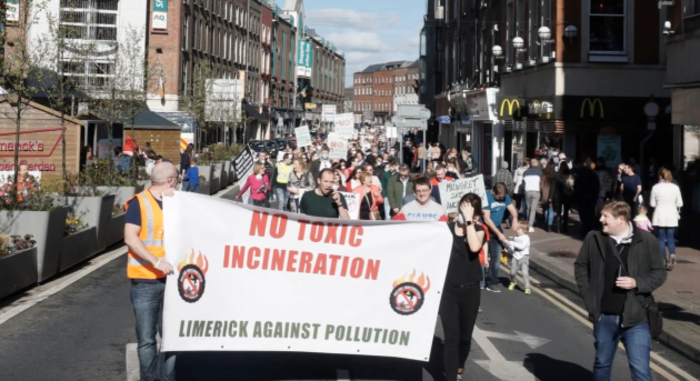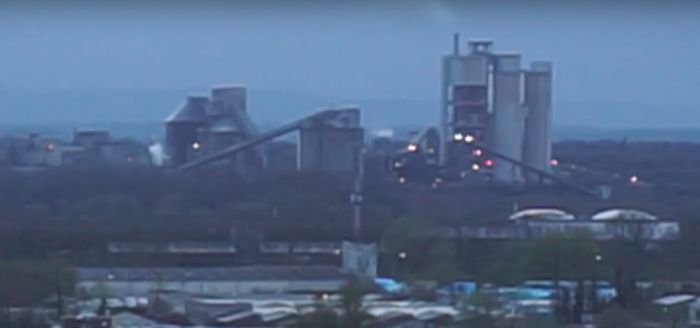'We don't trust them': Limerick residents fear Irish Cement dust emissions
The local cement plant is owned by a subsidiary of CRH, one of Ireland’s biggest companies.
WHEN RESIDENTS OF a housing estate in Limerick woke up last month to find their cars covered in dust, they weren’t long in pointing the finger of blame.
Irish Cement has a factory just a few minutes away that sends cement to many of Ireland’s largest construction firms.
Locals were convinced that the dust had come from the facility – and were proven right following an investigation by the Environmental Protection Agency (EPA).
While authorities say that the dust wasn’t harmful to people, locals claim that dust emissions from the plant happen too regularly and are a cause for concern.
They are now worried about plans to let the company burn alternative waste such as used tyres and solvents at the plant, claiming that the emissions could be a health hazard for people living nearby.
Over 1,000 people, including many prominent local politicians, joined a recent march opposing the new development.
 Protest against Irish Cement plans
Protest against Irish Cement plans
However, the company and local authorities have repeatedly said that there will be no hazardous emissions as a result of the expanded facility. This is what you need to know about the growing dispute:
Irish Cement and dust
Irish Cement is a subsidiary of building materials giant CRH, Ireland’s largest indigenous company.
The company’s presence in Limerick stretches back to the 1930s. It manufactures cement at its facility in Mungret, which is located a few miles outside of Limerick city centre.
There have been several reports of dust emissions from the plant stretching back years. One of these occurred in July 2015, when residents of Castlemungret estate in Limerick found their cars and gardens covered in dust.
There was a similar incident last month, when dust from the factory covered cars in several Limerick estates. Despite reassurances from the authorities, locals say they are worried about the health impacts of the emissions.
 Dust from Irish Cement on a car
Dust from Irish Cement on a car
The latest emission came shortly after the local council gave Irish Cement planning permission for an expansion at its facility which would allow it to burn waste such as used tyres and solvents.
Many locals are strongly opposed to the expansion and recently organised a large march through Limerick to demonstrate their anger.
Objections
Locals say that Irish Cement initially denied it had anything to do with the recent dust emission. A report in the Limerick Leader in early April quoted a company spokesman as saying that there was “no incident, no blow out from the factory”.
A ‘blow out’ is an industry term that refers to an incident more harmful than a normal dust emission.
However, last week Limerick City & County Council issued a joint statement with the HSE and the EPA saying that that the dust people found on their cars likely did come from the factory, after which Irish Cement apologised.
Tim Hourigan, the chair of local group Limerick Against Pollution, says the apparent delay in admitting responsibility shows that Irish Cement can’t be trusted.
“The standard used is that no health complaints made outside a small time window are counted, and people are unaware of this,” he says.
“We talked to people who woke up with problems with their breathing, and what we’re saying now is if there are dust emissions and you have a health problem, report it immediately.
“Our concern is if this is as bad as the company has been doing with (dust emissions), why would we trust them to burn tyres and chemical solvents?”
He adds that many locals are opposed to the factory expansion and also want the EPA to monitor the plant more closely for emissions.
Irish Cement’s version
For its part, Irish Cement maintains that it did not deny initial reports of an incident.
The company says that it received several queries over the weekend if there was a ‘blow out’ at the plant, and it said there was not. While it was later confirmed that there was an ‘emission’ from the plant, these are two different things, it says.
The company sent Fora a copy of the initial statement it issued, which read: ”There has been no ‘blowout’ at Mungret Cement factory. Irish Cement was contacted by several neighbours earlier today regarding dust on some cars.
“Irish Cement personnel visited the area and are liaising with the individuals in question.”
Following the investigation by the EPA, and the confirmation that there were dust emissions from the plant, the company issued the following statement:
“The company apologises for any inconvenience caused to its neighbours and commits to continuing to work with all the agencies and local communities to rectifying the situation.
“Irish Cement met with the EPA this week, and has also taken a number of proactive steps locally. Company personnel are visiting neighbours and have made arrangements for car washes and cleaning of affected properties.”
 The Irish Cement plant
The Irish Cement plant
In a statement sent to Fora, the firm says that its expansion is part of a move away from fossil fuels and towards different sources of energy.
It says that the because burning at the new facility will take place at such a high temperature, the new development “will have no impact on the emissions from the factory, apart from reducing carbon-dioxide emissions”.
What happens now?
Limerick council says that it is now is installing air-quality monitoring equipment at various locations across the city.
It says that this “is mirroring a number of other councils who have installed similar equipment”.
Asked by Fora if it’s concerned about Irish Cement’s expansion, a council spokesman added: “Limerick City and County Council is satisfied that it would not adversely affect existing air quality in the area.”
The facility needs two things to go ahead as planned: planning permission to build the expansion, and a licence from the EPA to burn the different types of waste.
A spokesman for Irish Cement says that the company has applied for the new licence from the EPA, however he adds that planning for the facility must be approved first.
While the council has approved the plans to expand, the final decision will go to An Bord Pleanála after dozens of locals submitted objections. The planning body is set to make a final decision by early August.
Sign up to our newsletter to receive a regular digest of Fora’s top articles delivered to your inbox.






